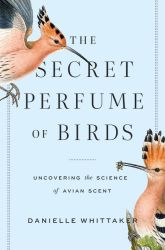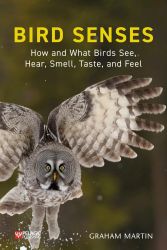7-minute read
keywords: ethology, olfaction, ornithology
To successfully navigate their world, organisms rely on numerous senses. Birds are no exception to this; and yet, for a long time, people have been convinced that birds cannot smell. This came as a surprise to evolutionary biologist Danielle J. Whittaker. Given that smell is effectively chemoreception (the sensing of chemical gradients in your environment) and was one of the first senses to evolve, why would birds have no use for it? The Secret Perfume of Birds tells the story of 15 years spent investigating the olfactory capabilities of birds and provides an insider’s account of scientific research.

The Secret Perfume of Birds: Uncovering the Science of Avian Scent, written by Danielle J. Whittaker, published by Johns Hopkins University Press in March 2022 (hardback, 277 pages)
The thing about The Secret Perfume of Birds, and something that might test the patience of some readers, is this: it is effectively a research memoir. Rather than a textbook-style review of what we know about bird smell, Whittaker takes you chronologically through her research, not sparing the reader from the dead ends and sometimes confusing results that come out of biological fieldwork. But, before delving in, she first sets the stage with some history and some information on her study system.
Whittaker traces the notion of avian anosmia (i.e. the absence of smell) to that famed US naturalist Audubon. In 1826, he published his results on experiments with what he thought were turkey vultures who proved unable to locate rotting prey. Already in 1837, Charles Waterton criticized him by pointing out that he had actually used black vultures that rely on eyesight to find prey. Never mind. The myth took hold in both the scientific and popular imagination and has stayed firmly lodged there until very recently, despite pioneering research in the 1960s by e.g. biologists Bernice Wenzel and Larry Hutchison, and medical illustrator Betsy Bang. Whittaker came to this topic in 2007 when she joined the research group of bird biologist Ellen Ketterson and started working on the dark-eyed junco. This small and unobtrusive New World sparrow is widespread in North America—just one more Little Brown Job on a birdwatcher’s checklist—but that makes them an ideal model species. “Have you ever tried to catch a bald eagle?” (p. 28), she quips when asked why she does not study something more exciting such as birds of prey.
“[This book is] effectively a research memoir. […] Whittaker takes you chronologically through her research, not sparing the reader from the dead ends and sometimes confusing results […].”
The first half of the book focuses on fieldwork and behavioural experiments and introduces one very special gland. To keep their feathers free from parasites and generally in tip-top condition, many birds rely on the uropygial gland (also known as the oil or preen gland). Located at the base of the tail, this gland secretes preen oil that birds daub on their bill and then spread all over their body during a good preening session. It also provides a source of body odour. In experiments, juncos responded differently to their own preen oil versus that of a stranger. Is odour just an incidental byproduct of preen oil? Chemical analysis revealed that preen oil composition changes during the breeding season. However, where other ground-nesting birds seem to chemically camouflage their nest, juncos produce smellier preen oil with more lightweight, volatile compounds. Could this be olfactory communication?
Thus armed with the first indications that juncos are capable of smell, the subsequent two chapters delve into a range of choice experiments to establish whether juncos actually care about smell and use it as a source of information to e.g. recognize each other, advertise health and nutritional status, respond to territorial intrusions, and choose mates. Especially that last question, mate choice, led to further research to see if there are correlations between preen oil composition and quality and (genetic) compatibility of mates. Along the way, she discusses other research, often on mammals, that shows the many functions of pheromones and other chemical signals. Her results are always interesting, but frequently tantalizing and not quite conclusive. This is in no way intended as a slight towards Whittaker. Having spent five years on mate choice experiments in fish myself, I can sympathize with the real-world time and budgetary constraints of biological fieldwork. Her results instead represent the typically slow and incremental increase of our knowledge.
One narrative thread that runs through The Secret Perfume of Birds is the unexpected directions research can take. Midway through, the book takes a decisive turn when Whittaker meets Kevin Theis who asks her whether she had noticed that the volatile compounds in junco preen oil are byproducts of microbial metabolism. This leads to a fruitful collaboration that starts by showing that bacteria in the uropygial gland are the source of a bird’s odour. From there, her questions inevitably turn to the role of the bird’s microbiome (i.e. the totality of an organism’s microbial fauna). Do hormonal levels influence scent by influencing microbiome composition? Do sex and grooming influence the spread of bacteria between individuals? And, since parents do not pass them on to their offspring, how do offspring obtain these much-needed bacteria? Then there are the major histocompatibility complex (MHC) genes that code for immune system proteins. Research in humans and other animals has suggested they play a role in odour and mate choice, so what about birds? And do MHC genes, via the immune system, affect the bacterial community responsible for scent production? These are just some of the questions Whittaker tackles here. A final chapter looks at the understudied role of odours in female behaviour, in particular in the context of sexual selection, such as mate choice by males and competition amongst females.
“Whittaker convincingly busts the myth that birds cannot smell, even if many of the details are still being worked out.”
Only occasionally does the memoir aspect of this book discuss Whittaker’s career: from a lost English major to the research director of the BEACON Center for the Study of Evolution in Action in Michigan*. Nevertheless, she is refreshingly frank about the hardships of navigating academia and finding employment. I think her choice to keep the focus squarely on the research is a good one: the book already meanders a bit by narrating her research chronologically. Readers will benefit from a background in biology or an interest in how science is done. To her credit, Whittaker does everything she can to attend to her audience. The book is well organised with section headings providing a clear structure. She provides basic background information on genetics when discussing the microbiome, but avoids going into the jargon-filled weeds when discussing MHC and the complexities of the immune system. A glossary with clear entries will demystify whatever terminology remains. And, where needed, illustrations are included (though some of the stock images contain extra labels that are neither explained nor relevant). The only criticism I had in this regard was her reference list: rather than the usual alphabetical listing, references are organised chapter-wise in the order in which they are discussed. However, because there is no connection to the main text via e.g. superscripts, this is neither a proper notes section nor an easily searchable bibliography.
It is encouraging to see that the efforts of her work are slowly rippling outwards. Nosing through my copy of the Handbook of Bird Biology from 2016, I noticed mention of her work, though this book still erred on the side of caution, considering well-developed smell in birds rare. Graham Martin, both in his books for a professional and a popular audience mentions Whittaker’s research and fully acknowledges how the last 20 years of research have clarified that smell in birds is taxonomically widespread and has many uses, though it remains understudied. Overall then, Whittaker convincingly busts the myth of avian anosmia, even if many of the details are still being worked out. The Secret Perfume of Birds might require some patience but rewards the reader with fascinating insights into the fields of animal behaviour and chemical communication.
* Observant readers might have noticed that between the manuscript going to press and the book being published, Whittaker radically shifted her career towards palaeoclimatology and became the managing director at the Center for Oldest Ice Exploration (COLDEX) in the USA.
Disclosure: The publisher provided a review copy of this book. The opinion expressed here is my own, however.
Other recommended books mentioned in this review:
__________________________________________________________________
__________________________________________________________________








